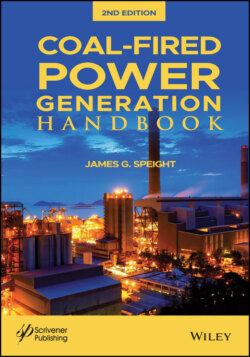Читать книгу Coal-Fired Power Generation Handbook - James Speight G., James G. Speight - Страница 83
3.8.3 Pipeline
ОглавлениеAnother method to transport coal is through a slurry pipeline. This connects a mine with a power plant where the coal is used to generate electricity. Coal slurry pipelines use a slurry of water and pulverized coal. For pipeline shipment, the coal is ground to approximately the size of coffee grounds and mixed with water to form the slurry. At the power plant the coal is either fed directly to the fuel preparation system or to a pond where the coal settles out and, at a later date, is re-slurried and then pumped to the fuel preparation system. The ratio of coal to water is approximately 1 to 1.
The coal removed from the mine is crushed to a diameter of around one millimeter, and is mixed with water in holding tanks with agitators, which keep the coal in suspension in the water. The pipeline consumes around a billion gallons of water annually. After three days the slurry reaches the end of the pipeline, at the Mohave power plant, where it is held in agitated tanks, for immediate use, and in drying ponds, for later use. Heated centrifuges are used to get the water out. As of 2006, the plant was shut down because the coal and water supply terms are being renegotiated.
Coal slurry pipelines are potentially the least costly available means for transporting coal to any location, measured in economic terms. Whether this is true with reference to any particular pipeline can only be determined by detailed evaluation of the conditions of the route. The current coal transportation scenario does not offer any choices between slurry pipelines and rail-road, which undoubtedly will necessarily minimize the cost of transporting coal. In this context the present times warrant assessment of the potential economic, environmental, and social implications of coal slurry pipeline development and transportation of coal through it.
However, there is need for caution. The large water and energy requirements for coal slurry pose a significant barrier to further deployment, especially in arid regions of Australia and the western United States.
The coal log pipeline is another technology for transporting coal in which coal at the mine site is treated and compacted into cylindrical shapes (coal logs) (Liu et al., 1993). Then the coal logs are injected into an underground pipeline filled with water for transportation to destination which may be one or more than one power plants, or to a train station, a barge terminal, or a seaport, for intermodal transportation.
The coal must have been cleaned and crushed, with a binding agent comprised of coal pitch, bitumen, or wax. The coal mixture is then tightly compressed and compacted as coal logs that are 5% to 10% thinner than the transportation pipeline. The logs are injected into a pipeline and pumped along using water. The pipeline can deliver the coal to coal-fired electric power stations or coal storage areas. The coal logs must then be crushed for use in fluidized bed, cyclone, or chain-grate stoker coal-burning boilers or pulverized for use in pulverized-coal combustors.
Proponents of the coal log technology claim that in addition to being more cost effective than coal slurry, the capsule pipeline is also more environmentally sound because the coal logs eliminate coal dust erosion of the pipe interior and erosion of coal fines by rain at the power plant storage site.
Since coal must be relatively dry before it can be burned efficiently, so the coal must be dried after it arrives at the power plant. Coal transported as slurry requires drying and electricity generation will be substantially less if it is not dried effectively.
Coal logs do not require as much drying because they are packed so tightly that they do not absorb much water, and any water originally in the coal is squeezed out during compression.
